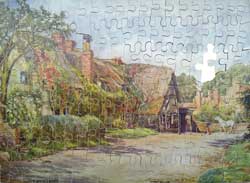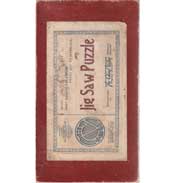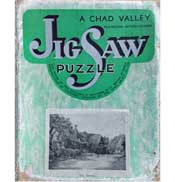Chad Valley jigsaws
Whilst researching the background to our GWR jigsaws we realised that, as well as puzzles marketed under their own brand, Chad Valley produced promotional jigsaws for several companies other than the GWR, sometimes re-using existing Chad Valley images. After 1945 they also marketed some of these promotional jigsaws under their own brand, including some of those originally produced for the GWR. We have added a small, but representative, selection of these promotional and re-branded puzzles to our collection.

'Chad Valley Works (the local centre of industry)'
Courtesy of WoolworthsMuseum.co.uk
Chad Valley Co. Ltd.
The company had its origins as a printing business established by Anthony Bunn Johnson in Birmingham in the early 19th century. Under the management of his son Joseph and grandson Alfred the company moved to the suburb of Harborne in 1897. This was in the valley of the Chad Brook, which gave its name to the district of Chad Valley. The company registered the trade mark Chad Valley for use on its products, subsequently changing the company name to The Chad Valley Company Limited in 1920.
The purpose built factory, as seen on this early postcard, was adjacent to Harborne Station which was at the end of a short LMSR branch. It was served by its own siding which it later also shared with a Birmingham Corporation facility. Whilst the line closed to passengers in 1934 it continued to carry goods traffic both to and from the factory until 1963. The building was enlarged and the company grew through several acquisitions becoming a well known and respected manufacturer of quality toys. In 1938 the company sought, and were granted, permission to produce a pair of top-of-the-range dolls and a jigsaw puzzle depicting the Princesses Elizabeth and Margaret Rose. This quickly led to them being awarded a Royal Warrant as 'Toymakers to Her Majesty The Queen', later to be amended to 'HM Queen Elizabeth, The Queen Mother' when Princess Elizabeth became Queen in 1952.
Cheaper foreign competition began to increasingly affect business, and the company finally ceased trading in the 1970s. The Harborne factory itself closed in 1972 and suffered a devastating fire a year later. The site of both the factory and station have been extensively redeveloped but the former branch line survives as a green corridor called the 'Harborne Walkway'. The trade marked name was bought by various companies (including at one time Woolworth's) and at the time of writing lives on as a brand exclusive to the Argos stores.
Jigsaw production
All Chad Valley jigsaw puzzles were manufactured by the company at their Harborne factory and were all made from 3-ply wood, but the thickness and quality of the wood did sometimes vary, as could the quality of cutting. The pieces varied considerably in shape and size as the puzzles were cut out by hand with different operators developing their own personal style, so some very delicate pieces could result. This also helps explain the slightly flexible number of pieces each box actually contained. All finished jigsaws were checked for completeness and a packing slip initialled by an overseer was put in the box as confirmation. These small pieces of paper were often lost or discarded but a number of puzzles in our collection still contain their original slip.The September 1931 edition of the Great Western Railway Magazine carried a four page illustrated article detailing a visit to the Chad Valley factory in Harborne. A gallery of photographs taken from the article can be seen by clicking or tapping on the thumbnail image.
 Click or tap to scroll through a gallery of Chad Valley jigsaw adverts
Click or tap to scroll through a gallery of Chad Valley jigsaw advertsChad Valley jigsaws. Author's collection
Jigsaw range
Chad Valley produced a vast number of wooden jigsaw puzzles of varying sizes and in different style boxes starting in the early 1920s right up until the late 1950s. Many of these puzzles were sold under their own name or were produced to be sold by others such as Boots. They also produced both individual, and ranges of, promotional jigsaw puzzles such as those for the GWR, Dunlop, and Cunard amongst others.From about 1945, Chad Valley published a few examples of previous promotional jigsaws under their own name. These were sold in varying styles of box with varying designs of label and were often a different size to the 'original' puzzle. One example of a GWR promotional puzzle known to have been republished this way is Historic Totnes which Chad Valley sold in a traditional lift-off lid type box with wrap around guide picture from about 1945. The Carter Paterson branded London Highways puzzle was sold from about 1950 with British Railways branding and, being heavily cropped on the right to remove the Carter Paterson van, that version also lost the aeroplane and Tower Bridge! Examples from the Dunlop, Boots and Cunard ranges of promotional puzzles, amongst others, were also republished under Chad Valley branding.The opposite also appears to have happened with certain puzzles originally published under the Chad Valley brand appearing with promotional branding such as the one shown below.
Our interest obviously lies with those jigsaw puzzles initially produced for the GWR, but we do have a number of other examples of promotional and republished jigsaws in our collection. These have been grouped according to origin.
~~~~~~ ooooooOOOoooooo ~~~~~~
Navigate between pages using the drop down list on the right of the secondary menu bar
Click or tap on any jigsaw thumbnail to see a larger image.
~~~~~~ ooooooOOOoooooo ~~~~~~
An early Chad Valley jigsaw
This painting depicts an unidentified, and probably fictitious, old country smithy. Towards the bottom left it is signed by the artist Sidney Currie who died in 1930 so the painting may well have been completed during or before the early 1920s. This example comes in a red lift-off lid box approximately 9½" x 5¼" x 2⅝" deep with a large label, but no guide picture. What is presumably the catalogue number of the puzzle is printed on the label (No.4805), and the end of a very small typed name label remains on one lip of the lid. The main label is damaged and looks to have once been overlaid with a small label amending the number of pieces which someone has removed. Under a strong light it is possible to just make out 'ABOUT 80 P' on the original label. We counted our puzzle as having 138 pieces, plus one missing. The main label itself appears to have been applied over a slightly smaller one.
The company changed its name to The Chad Valley Company Limited in 1920, so our version of the puzzle must date from the very early 1920s. It is possible that the original smaller label dated from before the name change which would suggest that the puzzle was first produced in 1919. Whilst the label states that the pieces were cut to interlock, our example was partly cut around the outline of the buildings, as can be seen in the larger image. A similar style of cutting was later employed with two of the GWR branded puzzles (Swansea Docks, and St. Julien, both first published in 1928).
This particular painting was destined to be used over many years on puzzles of varying sizes. The later Chad Valley jigsaw advertising sheets shown above list The Smithy as no. 2194C with 120 then 150 pieces, whilst it is also advertised on a BOOTS branded sheet as having 200 pieces.
We have in our collection a Chad Valley branded version of this puzzle with 200 pieces contained in a small marbled green book type box approximately 6" x 7⅝" x 2" deep









